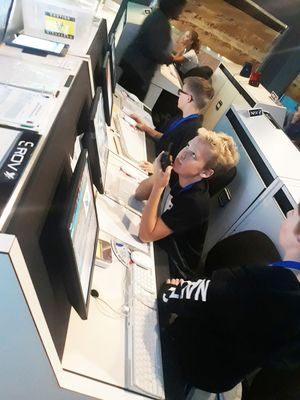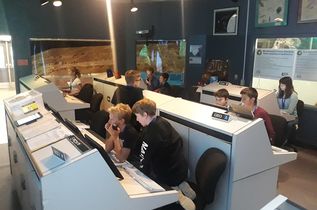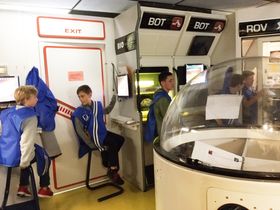STEM: GISW Students take a trip to Mars

On November 4, 2019, the scientists and robot FuF groups met with their teachers Dr. Ellenrieder and Mr. Thiemeyer, to take part in a project at the Challenger Center for Space Science Education (http://www1.pgcps.org/howardbowens/).
The school bus left after the third period to take us to the Challenger Center. After a short lunch break the program began. Sitting in a small auditorium we were introduced to the topic and our mission goals. In a short video followed by a presentation, we were told that NASA had built a station on the Mars moon, Phobos, so that astronauts could live there. Part of our mission was also to find water and possibly other life forms on planet Mars. We also got tips and hints on how to work with the computers we would use for that operation.
Next we were divided into two groups and assigned our positions. I became the "Mission Commander", others were weather experts, biologists, engineers or other personnel. Each group had a teacher and a supervisor for assistance.
The first assignment for my group was to fly in the rocket from the Phobos station back to Mars. So we went aboard the space shuttle through a dark revolving door. Inside the shuttle were different workplaces with computers and equipment for each of our positions. Everyone found their place quickly and started working. The tasks we had to do in order to land on Mars were shown on our monitors. With microphones and walkie-talkies, we were able to communicate with the group on Mars. Some of us had to observe the weather while others built a rover for landing. During our flight we had to solve several problems. For example, we had a sudden oxygen leak and had to deal with an asteroid that came right at us. But with some smart moves and a lot of team work we successfully managed the first part of the expedition.
After that, my group went to the station on the moon Phobos. From there we had to control the landing of the space shuttle on Mars, again. In addition, the asteroid's crater had to be explored and the astronauts who were on Mars also had to be helped, because the asteroid had caused damage. Luckily we were able to rescue the astronauts. We also found water in the asteroid crater and even discovered an alien.
At the end, both our groups were highly praised for our success in all our missions, which other groups had failed to achieve. Unfortunately, it was time to go back to school to work on our personal missions at the GISW.
This field trip was a fantastic experience.
Commander Sophie T. (8B)


